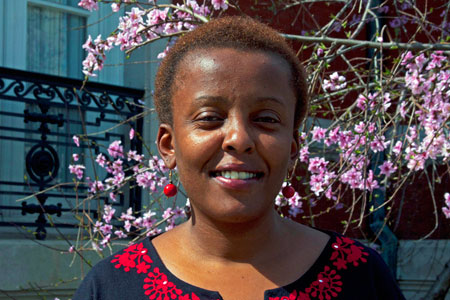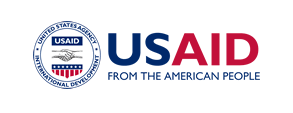The Health Policy Project ended in 2016. Work continued under Health Policy Plus (HP+) until 2022.
NEWS & VIEWS
Data from new website used to urge policymakers to improve health and HIV services for vulnerable women in Kenya
Posted April 10, 2012
|
|
Photo: Dr. Nduku Kilonzo, manager of an NGO for women’s health and HIV services in Kenya, has been a lifelong supporter for improving the well-being of vulnerable women and girls. Photo by Elizabeth T. Robinson/HPP |
As a teacher in rural Kenya, Nduku Kilonzo never thought she would become involved in women’s health, gender issues, and HIV. However, it was during her time as an educator in the 1990s when she began to realize disparities that threatened the health and well-being of her female students. She recalls that, “Women were looking after the sick, or couldn’t afford to send their daughters to school because they were spending money on health care.”
Over the years, her interest in gender issues and women’s health crystallized into a focus on how gender norms affect the spread of HIV, especially the relation between gender-based violence and HIV.
Acquiring HIV can be linked to violence and women who are living with HIV are more likely to suffer from violence. Women who suffer from violence are often unable to negotiate safer sex. According to Kilonzo, gender-based violence is pervasive, but the response to this problem is often lacking. “Programs for HIV say ‘Be faithful, practice abstinence, use condoms,’ but for women and girls who face violence, or coerced sex, this makes no sense,” says Kilonzo.
Eventually, Kilonzo obtained a doctoral degree and plunged into work as manager of the Kenyan non-profit organization, LVCT, where she and her colleagues provide sexual and reproductive health services to some of the most vulnerable women in the country. Last year, they served more than 15,000 survivors of sexual violence and provided HIV counseling and testing to over a half million people, the majority of whom were women.
A national response to HIV needs to address gender-based violence and include policies and legislation to protect women from violence as well as provide services to survivors. To do so, government leaders and decision-makers need accurate information and evidence they trust to formulate policies that protect women from violence and prevent HIV, and to provide appropriate services for those who are living with HIV.
As a member of the gender and HIV working group on Kenya’s national HIV/AIDS program, Kilonzo discovered that providing this type of data and information to policymakers was more difficult that she initially imagined. “We’d have a few studies here, a few studies there, but there wasn’t a comprehensive place that I could consult to show the evidence,” she said.
In 2010, Kilonzo was one of 50 international experts who were asked to review a new website, What Works for Women and Girls: Evidence for HIV/AIDS Interventions. The website provides information for people involved in policy and programs related to women and girls’ health in developing countries. Materials are based on a comprehensive review of available evidence from more than 2,000 articles and reports on programs and studies conducted in more than 90 countries. Users can share information on interventions for which there is substantial evidence of success: from HIV prevention, treatment, care, and support to policies and programs encompassing violence and gender norms.
“What attracted me to What Works for Women is it went outside of traditional thinking on HIV prevention to look at women’s needs and also larger systems,” says Kilonzo. “We need to look at policy, legal and social issues, and say ‘What do we need to do to remove the barriers or enhance the opportunities to provide progress for women?’”
Last year, Kilonzo used information from the website in a presentation to officials from the Kenyan National AIDS Control Council, which oversees national plans for HIV prevention and meeting the needs of people living with HIV. Council officials responded to the body of evidence in Kilonzo’s presentation with a commitment to action. “As a result, in the current national plan on HIV in Kenya, we’ve been able to keep pushing the agenda for women. Now we have evidence for what can be done: These are the options. These are the opportunities.”
In the last two years, there has been a major shift in attention to gender issues related to HIV on the part of governments, institutions, and donors. “You can almost feel the ground shifting,” she says. “But there is still a long way to go. You can’t prevent HIV if women don’t have food; they’ll be vulnerable to increased risk of acquiring HIV. We need dedicated financing for women and HIV.”
In March 2012, Kilonzo was invited to speak about gender-based violence and HIV at the White House. Her message? “Gender-based violence is an epidemic with far reaching impacts on health, education, and the economy. We cannot continue to give it divided attention or ignore it. We also need to focus on the poorest women. And we need to build the evidence for programs and expand services.”
With the What Works for Women website, Kilonzo—and advocates across the world—have a resource to match their passion for women’s health with the information they need to influence policymakers to increase support to meet the needs of women and girls in the global HIV response.
Download printable PDF version
About the What Works for Women Website
What Works for Women & Girls is supported by the U.S. President's Emergency Plan for AIDS Relief (PEPFAR) and the Open Society Foundations and is being carried out under the auspices of USAID's Health Policy Project and the Public Health Institute.
For more information, visit the website at www.whatworksforwomen.org
What's New
- Something to Build On: “Innovation Exchange” Celebrates the Health Policy Project’s Close and a New Beginning
- What Will it Take for Tanzania to Achieve ART Targets and Ensure Long-Term Sustainability of the HIV Response?
- Helping Kenya’s County Leaders Advocate for Increased Health Investments
- HPP Holds Working Meeting on Ensuring Responsible PEPFAR Transitions for Key Populations
- Health Policy Project Celebrates 2016 International Women's Day
- HPP Staff Participate in White House Conference on HIV Stigma Reduction


